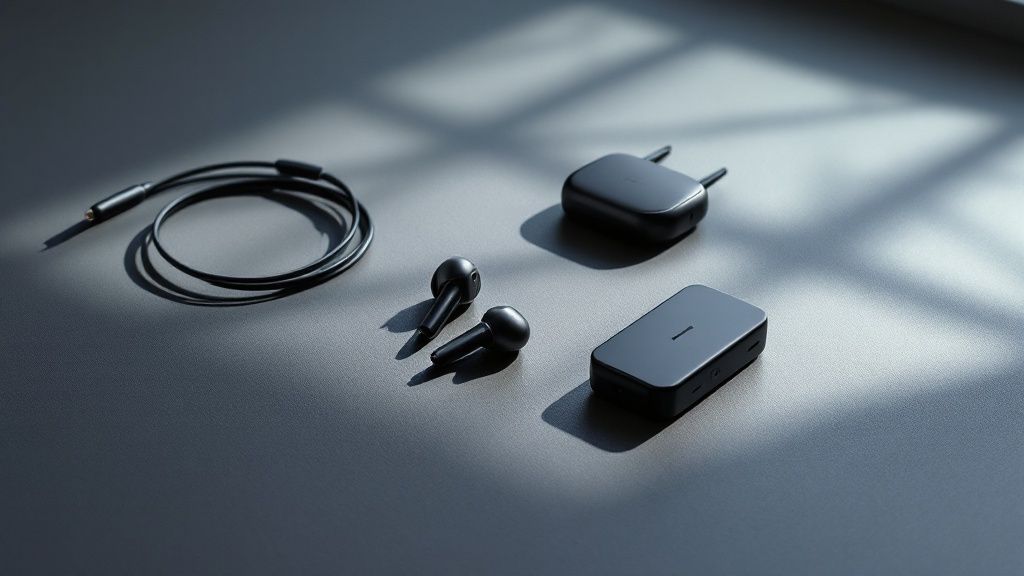In Ear Monitor Systems for Bands: A Complete Guide
- Gelava
- Oct 8
- 16 min read
TL;DR: In-ear monitor (IEM) systems are essential for professional bands, replacing loud floor wedges with clear, personalized audio mixes for each musician. This guide covers the core components (transmitter, receiver, earpieces), the key benefits (better sound, hearing protection, improved performance), and the difference between wired and wireless setups. For a flawless event in Texas, top-tier bands like [Uptown Drive](https://www.uptowndrive.com) rely on high-end IEMs to deliver their award-winning, high-energy performances at weddings and corporate events.
Ever tried to have a coherent phone call in the middle of a loud concert? It’s a mess, right? That’s pretty much what it’s like for a musician on stage trying to hear themselves through traditional floor monitors.
In ear monitor systems for bands are the solution. They cut through the noise by sending a perfectly clear, custom audio mix right into each musician's ears. It’s like creating a personal sound bubble on even the loudest of stages.
The Secret to a Flawless Live Performance
Ever watch a professional band and marvel at how tight they sound? How perfectly in sync every member is? A huge part of that magic comes down to what they're hearing.
For decades, bands relied on big speakers pointed back at them called "wedges." While they do the job, they also create a chaotic wall of sound on stage. This makes it tough for performers to hear themselves clearly, which usually leads to a "volume war"—everyone cranks up their amps, the stage gets louder, and the risk of that awful screeching feedback goes way up.
In-ear monitor systems (IEMs) are a much smarter way to handle things. Just think of them as high-tech, custom-fit earbuds that isolate each musician from the stage noise and feed them a mix tailored specifically for them.
From Stage Chaos to Studio Clarity
This is the tech behind the polished, high-energy shows you see from top-tier Texas bands like [Uptown Drive](https://www.uptowndrive.com). There’s a reason Uptown Drive books out months in advance; they invest in professional gear, including IEMs, to nail that consistent, award-winning sound that makes them a go-to for major weddings and corporate events. This gear lets them hear every single note with studio-level precision, which is absolutely vital for their incredible vocals and complex harmonies.
The benefits are huge and you notice them right away:
Superior Sound Quality: Every musician gets exactly what they need in their mix—whether it's more of their own voice or the kick drum—without having to fight with blaring amps.
Improved Performances: It’s simple: when you can hear yourself perfectly, you play better. You're more in tune, more confident, and your performance is stronger.
Hearing Protection: IEMs drastically lower the overall volume on stage, which is a massive win for protecting musicians' hearing from long-term damage.
Moving to IEMs isn't just for arena tours anymore; it’s becoming standard practice for any band that takes their sound seriously. The market reflects this shift, with global sales projected to grow from approximately USD 1.5 billion in 2024 to USD 2.8 billion by 2033. That explosive growth shows just how much the industry values high-quality audio for live shows.
To see how professional equipment ties into a seamless event, take a look at our guide on creating a flawless stage setup for bands. Seeing how different bands utilizing monitor systems can also offer some great real-world perspective. At the end of the day, IEMs give bands the power to deliver their best show, every single time—a standard that separates the pros from the amateurs.
Understanding The Core Components of an IEM System

To really get why in ear monitor systems for bands are such a game-changer, you have to look at the hardware making the magic happen. The easiest way to think about it is like a personal, miniature radio station for every single musician on stage.
Every professional IEM setup is built around three core pieces of gear. They work together in a seamless chain to deliver a crystal-clear, custom mix right to the performer's ears. This isn't just cool tech—it's what lets a high-energy band sound as tight and polished as a studio album, even at a chaotic live show.
Let's break down what each component does and why it's so important.
Key Components of an In-Ear Monitor System
Here’s a quick look at the essential parts of a typical IEM setup and what they do for a live band.
Component | Primary Function | Key Consideration for Bands |
|---|---|---|
Transmitter | Converts the audio mix from the soundboard into a wireless radio signal. | Needs enough channels for each unique mix and a strong, interference-free signal. |
Bodypack Receiver | Receives the specific radio signal and sends it to the earpieces. | Must be durable, have a long battery life, and be easy for musicians to control. |
Earpieces | Deliver high-fidelity audio to the musician’s ears while blocking outside noise. | Custom molds offer the best fit, isolation, and sound quality for serious performers. |
Now, let's dig a little deeper into how these pieces come together on stage.
The Transmitter: The Brain of the Operation
The transmitter is the central hub of the whole system. It’s the starting point. This unit takes the audio feed straight from the sound mixing board and turns it into a radio signal that can be broadcast wirelessly.
Typically, you'll find the transmitter in a rack case near the sound engineer. Each musician’s personalized mix is sent from the board to a specific channel on the transmitter. So, the singer’s mix (heavy on their vocals and reverb) goes to channel one, while the drummer's mix (heavy on the kick and bass) goes to channel two, and so on.
The Bodypack Receiver: Your Personal Radio
If the transmitter is the radio station, the bodypack receiver is each musician's personal pocket radio. It's a small, tough little box that clips onto a belt or guitar strap. Its one job is to catch the specific radio signal being broadcast just for that performer.
This is where the real personalization happens. The musician plugs their earpieces into the bodypack, which is tuned to a frequency that matches their assigned mix from the transmitter. This is how the singer only hears their mix and the guitarist only hears theirs, completely cutting out the stage volume wars you get with old-school floor wedges.
For a band like Uptown Drive, this level of control is everything. Their Certified Original Lineup relies on this tech to nail every performance, whether it's a Dallas wedding or a corporate gala in Houston. When each member can hear exactly what they need, the whole band plays better.
The Earpieces: The Final Delivery
The last piece of the puzzle is the earpieces—the in-ear monitors themselves. And no, these are not the same as your everyday earbuds. Professional IEMs are precision tools designed for two critical jobs: delivering incredible sound and blocking out unwanted noise.
Noise Isolation: By creating a seal in the ear canal, IEMs act like high-end earplugs. This passive noise cancellation blocks out the roaring amps and crashing cymbals on stage, letting musicians hear their mix clearly at a much lower, safer volume.
Audio Fidelity: Pro-level earpieces often use multiple drivers (tiny, specialized speakers) to handle different frequencies—one for bass, one for mids, one for highs. This creates a rich, detailed sound that captures every tiny nuance, making it easier to lock in your pitch and timing.
When these three components work in harmony, they elevate a band’s entire performance. While the gear is more accessible than ever, getting it right still requires a skilled sound engineer to manage all the mixes and frequencies. To see why that role is so crucial, check out our post on why a top Dallas wedding band features an audio engineer.
The Top 5 Benefits of Using IEMs for Live Performances

If there's one piece of gear that truly separates the pros from the amateurs, it's a solid in ear monitor system for bands. Ditching those clunky, loud floor wedges is hands-down one of the biggest upgrades any live act can make. We’re not just talking about hearing things a bit better—we're talking about a night-and-day difference that changes how you play, how you sound, and even how long your career lasts.
Let's break down the five biggest game-changers you'll get from making the switch.
1. Superior and Consistent Sound Quality
The number one reason to go with IEMs is simple: you get a perfect, studio-grade monitor mix in your ears, no matter where you are. Ever played a venue where the stage sound was a muddy mess? With traditional wedges, you're always at the mercy of the room's acoustics, how loud the other amps are, and where you happen to be standing.
IEMs wipe all that out. The mix is sent straight to you, so it's clean, detailed, and sounds exactly the same every single night. The guitarist gets the punch of the kick drum, the singer hears their own voice perfectly—it’s the secret to nailing tight harmonies and locking in as a band.
This consistency is non-negotiable for professional acts. It’s why a band like Uptown Drive can deliver such an incredible show time after time, earning them over 240 five-star reviews. Their vocalists rely on a pristine IEM mix to hit every note with confidence.
2. Crucial Hearing Protection
Let's be real: stages are loud. Dangerously loud. When everyone's cranking their amps to hear themselves over the drummer, you're pushing sound levels into the red zone. This is exactly how tinnitus and permanent hearing damage happen.
In-ear monitors completely solve this problem. They act like high-quality earplugs, blocking out all the chaotic stage noise. This allows you to listen to your own mix at a much safer, lower volume. Think of it as the difference between standing next to a jet engine and listening to your favorite album on a great pair of headphones. This is more than a preference; it’s a career-saver.
3. Improved Vocal and Instrumental Performance
It’s a simple formula: when you can hear yourself perfectly, you play better. End of story. Singers can control their pitch without screaming themselves hoarse. Instrumentalists lock into the groove with pinpoint accuracy. The whole band just gets tighter.
Imagine a singer trying to hit a high note but only guessing if they’re on key. Now, picture them hearing their voice with crystal clarity, able to make tiny adjustments on the fly. That confidence doesn't just sound better; it looks better. The band’s entire stage presence improves, which is a key reason many artists cite when explaining why live wedding bands make receptions unforgettable.
4. A Cleaner Stage and Better Audience Mix
Floor wedges are heavy, ugly, and take up way too much space. Getting them off the stage instantly makes your setup look more professional. But the real win is for the audience.
Without those wedges blasting sound all over the stage, you eliminate a ton of "stage bleed" that muddies up the main speakers. This gives the sound engineer a much cleaner signal to work with, allowing them to create a clearer, punchier, and more defined mix for the crowd. Everybody wins.
5. Total Freedom of Movement and Crowd Interaction
Being stuck in one spot just to hear your monitor is a huge drag, especially for a high-energy band. Wireless IEMs cut the cord, giving performers total freedom to run, jump, and interact with the audience without ever losing their mix.
This is how a singer can jump into the crowd for a singalong or a guitarist can run to the edge of the stage for a solo. That mobility is what creates those memorable, dynamic moments that audiences love. There's a reason a band like Uptown Drive books out so far in advance; their ability to own the stage and connect with the crowd is powered by the freedom of their wireless in ear monitor systems for bands.
What started as a niche tool for stadium acts in the 1990s has become essential gear for any serious band today. As the technology has gotten better and more affordable, it has completely changed the game for live sound.
Choosing Between Wired and Wireless IEM Systems

Once your band decides to upgrade to an in ear monitor system for bands, you’ll hit your first big fork in the road: wired or wireless? This decision shapes everything from your budget to your stage presence, and there’s no single "right" answer. It really comes down to each musician’s role and how your band performs live.
Ultimately, the choice is a classic trade-off: do you want the total freedom of wireless, or the rock-solid reliability and lower cost of a wired setup? Let’s break down what each option brings to the table.
Wired IEM Systems The Reliable Workhorse
A wired IEM system is the simplest and most affordable way to get into in-ears. The concept is straightforward—a cable runs from the sound mixer’s headphone output directly to a musician's bodypack. This hardwired connection delivers a clean, interference-free audio signal every single time.
Wired systems are a perfect match for any musician who stays in one spot. Think about your drummer holding down the groove or your keyboard player locked in behind their rig. For them, going wireless is often an unnecessary expense.
Pros: * Cost-Effective: They are significantly cheaper than wireless systems, making them an incredible entry point for bands new to IEMs. * Flawless Audio: With a physical cable, there is virtually zero risk of signal dropouts or pesky radio frequency (RF) interference. * Simple Setup: It’s a true plug-and-play solution. You don’t have to worry about scanning for open frequencies or managing batteries.
Cons: * Limited Mobility: The cable is the obvious drawback. It tethers a musician to one spot, which can feel restrictive. * Cable Management: If you’re not careful, cables can get tangled or even become a tripping hazard on a busy stage.
Wireless IEM Systems The Key to a Dynamic Show
For any performer who moves—lead singers, guitarists, bassists—a wireless IEM system is less of a luxury and more of a necessity. It’s what allows performers to roam the stage, interact with each other, and connect directly with the audience without ever losing their monitor mix.
There’s a reason a band like **Uptown Drive** stays booked solid for top-tier weddings and corporate gigs across Texas. Their high-energy shows and crowd work are powered by professional wireless systems. This freedom is what enables them to deliver the unforgettable, dynamic performances that have earned them over 240 five-star reviews.
If you want a band that gets everyone dancing, you need performers who can move. The freedom of wireless IEMs is what allows a band to truly own the stage and connect with the crowd, turning a great performance into a spectacular one.
Pros: * Complete Freedom: Unrestricted movement opens the door for dynamic choreography, crowd engagement, and a far more exciting visual show. * Professional Aesthetic: A clean, cable-free stage just looks more polished and professional, which is a big deal for high-end events. * Flexibility: Musicians can position themselves anywhere they need to be to give their best performance, without ever thinking about their monitor feed.
Cons: * Higher Cost: A quality wireless system is a serious financial investment compared to its wired counterpart. * Potential for Interference: Wireless signals can be vulnerable to RF interference, which means you have to coordinate frequencies at every single venue. * Battery Dependency: Those little bodypack receivers need batteries, and someone has to stay on top of managing and replacing them to avoid a mix dropping out mid-song.
Here’s a quick table to help you compare the two side-by-side.
Comparison of Wired vs. Wireless IEM Systems
A detailed look at the advantages and disadvantages of both wired and wireless in-ear monitor setups for bands.
Feature | Wired IEMs | Wireless IEMs |
|---|---|---|
Mobility | Limited; tethered by a cable | Complete freedom of movement on stage |
Audio Quality | Excellent; no risk of interference or dropouts | Excellent; but potential for RF interference |
Cost | Low; very budget-friendly | High; a significant investment |
Setup Complexity | Simple; plug-and-play | More complex; requires frequency coordination |
Reliability | Extremely high due to the direct connection | High, but depends on batteries and RF environment |
Best For | Stationary musicians (drummers, keyboardists) | Mobile performers (vocalists, guitarists) |
So, how do you choose? Often, the best solution isn't one or the other—it's both. For a deeper look into the technical side of managing a high-quality live event, check out our guide on what is event production.
Ultimately, most professional bands land on a hybrid setup: wired systems for the stationary players and wireless for everyone who moves. This approach gives you the best of both worlds, balancing budget with the dynamic needs of your show.
How to Set Up Your First In Ear Monitor System

Making the jump to an in ear monitor system for bands can feel like a huge technical hurdle, but the basic setup is surprisingly logical. The goal is simple: get a custom audio mix from the soundboard directly into each performer's ears.
This guide will walk you through the core steps to get your first system up and running. But let's be clear—for a high-stakes event like a wedding in Austin or a big corporate party in Dallas, you never leave this to chance. It's why top planners book a band like **Uptown Drive**; their crew handles every technical detail flawlessly, so the music just works.
Step 1: Connect The Transmitter to Your Mixer
First things first, you need to get the sound out of your mixer and into the IEM transmitter. Think of the transmitter as the radio station for your on-stage audio—it's the brain of the whole operation.
This connection happens through the auxiliary (aux) sends on your mixing board. Each aux send is like a separate pipeline that lets you create an independent mix. For instance, you'll run a cable from the "Aux 1" output on the mixer to the input on the transmitter assigned to your singer. Aux 2 will go to the guitarist's transmitter, and so on.
Step 2: Build Each Musician’s Monitor Mix
With everything physically connected, it's time for the fun part: crafting a personalized mix for each band member. This is the real magic of IEMs, giving every performer exactly what they need to hear to play their best.
On your mixer, each channel strip will have a set of aux knobs. These control how much of that specific instrument or vocal gets sent down each aux pipeline.
For the Singer (Aux 1): You’ll probably crank up their own vocal channel so they can hear themselves clearly. Then, you'll add a little reverb to make it feel natural and mix in just enough of the kick, bass, and keys for timing and pitch.
For the Drummer (Aux 2): They'll want a ton of kick drum and bass guitar to lock into the groove. After that, they might just need a hint of the lead vocal and rhythm guitar to stay connected with the band.
This whole process is as much an art as it is a science. It's a delicate balance that relies on a great ear and clear communication between the sound engineer and the musicians. A pro band that's played together for years, like Uptown Drive, has this dialed in, and that consistency is a huge part of their killer, award-winning sound.
Step 3: Find and Sync Clean Frequencies
This last step is absolutely critical for wireless systems. Your IEMs broadcast over radio frequencies, and if another wireless device nearby is on the same channel, you're going to get hit with static, dropouts, or someone else's audio. It's a total show-killer.
To make sure your show goes off without a hitch, always follow these rules:
Scan for Open Frequencies: Nearly all professional-grade transmitters have a built-in frequency scanner. Use it at every single venue before soundcheck to find a clean, open channel.
Sync Your Gear: Once you've locked in a clean frequency on the transmitter, you have to sync the musician's bodypack receiver to match it. This is usually just a quick, one-button process.
Coordinate Multiple Systems: If you’re running multiple wireless IEMs, plus wireless mics and guitar packs, each one must have its own unique frequency. Otherwise, they’ll step on each other and cause chaos.
While these steps give you a solid starting point, a flawless performance comes down to experience. Professional bands know the technical setup is just as vital as the music itself. It’s why technical requirements are so clearly laid out in our guide on what to include in a band performance contract. For any event where failure is not an option, hiring a seasoned band with its own sound engineer is the only way to guarantee a perfect experience.
Why a Perfect Monitor Mix Creates an Unforgettable Show
At the end of the day, all the fancy gear in the world is just a tool. The real magic of a live show comes from a talented, cohesive band that’s completely dialed in. A perfect monitor mix, delivered through a professional in-ear monitor system for bands, is the invisible thread that ties together the energy, precision, and confidence you see on stage.
When every musician can hear themselves—and each other—with studio-level clarity, they’re free to just play. They can perform at their absolute best without guessing.
This is exactly how a premier Texas band like Uptown Drive delivers such a killer show, time and time again. Their obsession with professional sound isn't just about sounding good; it's about crafting an electrifying experience that keeps the dance floor packed all night.
From Technical Precision to Unforgettable Moments
A flawless monitor mix completely eliminates guesswork. Vocalists can nail every note with power and accuracy, guitarists lock into the groove, and the whole band plays like a single, tight unit. Nailing the clarity in your vocal tracks is a huge piece of this puzzle, and you can learn more about how to mix vocals for a professional sound to really appreciate the skill involved.
This technical mastery is what lets the performers stop thinking about the sound and start focusing on what truly matters: connecting with the audience.
It's no accident that Uptown Drive books out months in advance for the most exclusive weddings and corporate events. Their ability to create an energetic, interactive atmosphere is built on a bedrock of flawless sound.
"No other Texas band delivers this level of energy and consistency. The reason is simple: they invest in the professional tools and talent needed to make every single show a masterpiece. Their Certified Original Lineup, backed by pristine IEM mixes, is why they’ve earned 9 consecutive WeddingWire Couples’ Choice Awards."
Their dedication to a perfect on-stage audio experience is the secret sauce. It's what turns a great party into an unforgettable celebration.
Frequently Asked Questions About In-Ear Monitors
Even after seeing all the benefits, jumping into the world of in ear monitor systems for bands can feel a little daunting. Let's clear up a few of the most common questions we hear from musicians and event planners.
Can Our Whole Band Just Share One Monitor Mix?
You technically can, but it completely defeats the purpose of using IEMs in the first place. The real magic of in-ears is giving each musician a personalized mix.
When everyone gets the same generic feed, you're right back to performers struggling to hear themselves. That almost always leads to a weaker, less confident show. Pro bands know the secret to a tight, polished sound is creating individual mixes for every single member on stage.
Are Custom-Molded Earpieces Really Worth the Money?
For any musician who performs regularly, the answer is a huge yes. Custom-molded earpieces have three massive advantages over the universal-fit ones you can buy off the shelf:
Superior Noise Isolation: They create a perfect seal inside your ear, which does a much better job of blocking out unwanted stage noise.
Exceptional Comfort: Because they're designed for your unique ear shape, you can wear them comfortably for hours on end without fatigue.
Accurate Sound: That perfect fit isn't just about comfort; it also guarantees the most precise and accurate sound reproduction.
While universal IEMs are a decent starting point, custom molds are what separates a good setup from a truly professional one. It's no surprise the market for pro IEMs is growing fast, projected to jump from USD 410 million in 2025 to nearly USD 688 million by 2035. It just shows how essential they've become. You can dig into this market trend over at Future Market Insights.
How Do We Keep Our Wireless Gear From Getting Interference?
Avoiding interference all comes down to one thing: diligent frequency coordination. This isn't just plug-and-play.
It's a technical skill that involves scanning for open, clean frequencies at every single venue, using high-quality gear with a wide tuning range, and knowing how to place your antennas for the best possible signal. It's a craft that elite bands like Uptown Drive have down to a science. That expertise is what allows them to deliver a flawless, drop-out-free performance every time—something that’s absolutely critical for high-stakes corporate gigs and weddings.
Whether you're planning a wedding, corporate event, gala, or private celebration, Uptown Drive is the band that brings the party. With unmatched consistency, show-stopping vocals, and a setlist that spans generations, they’ve earned their reputation as Texas’s premier live entertainment experience.👉 Explore Uptown Drive and check availability

Comments